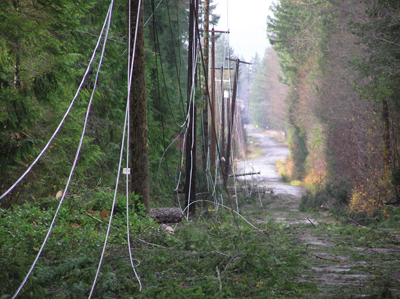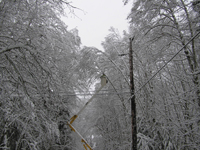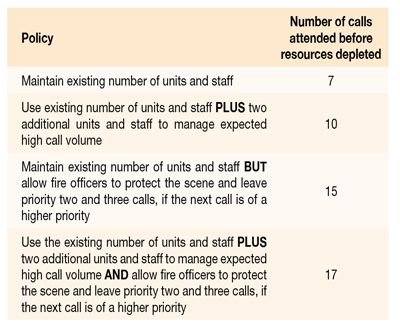
Features
Training
Resource allocation
In a perfect world, emergency responders would have the resources to address every call immediately and completely.
April 12, 2010
By Karin Mark and Len Garis
In a perfect world, emergency responders would have the resources to address every call immediately and completely. The reality is that during major events such as storms, which produce high call volumes, resources may be tied up by less serious incidents merely by virtue of when they are called in.

|
| First responders to a downed line call could use common criteria to evaluate the situation and inform their electric utility, ensuring an appropriate level of response by various agencies.
Photo courtesy BC Hydro
|
This was the case in British Columbia in the winter of 2006-2007 when five major winter storms stretched the capability of fire departments and BC Hydro to respond to public safety hazards related to numerous downed power lines.
The situation prompted BC Hydro and the fire service (represented by the Fire Chiefs’ Association of B.C.) to form a joint task force in early 2007 to improve the response in the future. The Mutual Response to Downed Power Lines Report, released in December 2009, includes 16 recommendations that address education and awareness, communications and co-ordination, operations and finances.
What also emerged was the beginning of an innovative risk-assessment approach that prioritizes calls for a more strategic response – and also suggests that changes to an agency’s response policy can significantly increase its resource capacity.
At the heart of this risk-based approach is a priority matrix for major events involving many downed lines. The matrix ranks calls into three categories based on risk, determined by cross-referencing the likelihood of the downed lines being energized with the potential for public interaction. For example, a line down across a remote road that leads to a hospital would be a priority one call, but a line down in a quiet residential area where no power outages have been reported would be a priority three call.

|
| Five major winter storms in 2006-2007 stretched the capacity of fire departments and BC Hydro. A risk-assessment approach that prioritizes calls improves a department’s ability to protect public safety by focusing resources on higher-priority calls.
Photo courtesy BC Hydro
|
That’s not to say that a perceived priority three call is not a serious public safety threat. The report is clear in stating that no downed power lines should be considered safe until an authorized electric utility representative declares such. However, in circumstances where response resources are stretched as a result of abnormally high call volumes, ranking of calls is necessary to provide a managed response.
At the moment, the culture within B.C.’s fire service is to send firefighting resources to all calls and to maintain fire crews at the scene until the issues are resolved or until firefighters are relieved by other agencies. Fire service calls are generally not triaged and many of them are also received by other agencies such as paramedics, police or utilities. Not surprisingly, this approach can quickly overrun department resources when call volumes are high.
By using a common ranking system, as proposed in the report, emergency responders could improve their ability to protect public safety by focusing their resources on higher-priority calls. For example, first responders to a downed line call could use the common criteria to evaluate the situation and inform their electric utility, thus ensuring an appropriate level of response by the various agencies.
“It’s a really clever way of looking at the problem,” noted FCA BC president Steve Gamble. “More importantly, this approach could be quite applicable to disaster planning and major emergencies, where you have multiple calls for service but resources are on the thin side.”
Building on the work of the task force, Surrey Fire Service studied the effects of several different response policies on a department’s capacity to respond. The policies ranged from maintaining existing units and staff to adding additional resources and allowing fire officers to protect a scene and then leave to attend to a higher-priority call.
The results of the experiment showed that certain policy changes could more than double a department’s response capability. The sample policies and effects are as follows:
 |
The report recommends that the ranking matrix be refined and tested under various scenarios through a risk-ranking workshop run by the fire service and BC Hydro. But even in its initial form, it illustrates the potential benefits of a risk-based approach in helping agencies to more efficiently and effectively manage their resources.
The report also addressed the issue of legal liability for local governments that adopt a priority matrix along with other of the report’s recommendations. A legal opinion obtained from the law firm Staples McDannold Stewart in Victoria indicated that local governments could shield themselves by adopting the recommendations as corporate policy. It further noted that local governments that do nothing to protect residents from downed lines are not likely to be insulated from possible legal action. The opinion states: “…The report provides a model for local governments to adapt to their particular circumstances for the purposes of adopting it and putting its recommendations into practice. As long as the recommendations are carried out consistently and competently, it will provide a needed service to the public and become an important part of the risk management strategy for local governments in this province.”
The report does recommend that local governments obtain their own legal opinions before adopting the recommendations. Other report recommendations directed to fire departments include:
- Firefighters should never attempt to move or come within 10 metres of a downed power line until the local electrical authority has confirmed it is safe;
- In advance of the storm season each year, BC Hydro and fire departments should undertake increased messaging to the public about the hazards associated with downed power lines, proper generator use and emergency preparedness;
- All firefighter training officers should participate in free train-the-trainer workshops on electrical safety offered by BC Hydro;
- When electrical hazards are present, fire departments should continue to explore safe alternative approaches to a scene, such as using a ladder to look inside a vehicle;
- Local governments should explore engaging a force of trained non-traditional responders to cordon off areas and provide traffic control in cases of downed power lines, in order to free up firefighters and BC Hydro crews;
- Fire departments should conduct a triage exercise like the one conducted by Surrey Fire Service to compare and contrast policies for managing high call volumes (a sample exercise is included in the report);
- Fire departments should develop contingency planning for extreme storm events that are likely to tax their ability to respond to downed power line hazards;
- If local governments intend to follow the recommendations in the report, it is recommended that their elected body adopt the recommendations as corporate policy, that the fire department consider adopting the sample Operational Guidelines included in the report, and that the organization obtain its own legal opinion.
In the wake of the report, members of the task force continue to work together to improve the mutual response to storm events. For example, they are exploring the widespread use of new and distinctive barricade tape to cordon off lower-priority downed lines, along with the use of light sticks to improve night-time visibility of this barrier. The tape, for example, includes wording such as “Danger – Electrical Hazard – Keep Back 10 Metres” rather than the typical “Caution – Keep Out” tape. In addition, further development of the priority matrix is planned for 2010-2011, as is the continued enhancement of BC Hydro’s web-based electronic interface that supports timely communication of information (for example, status reports) to first responder dispatchers in an effort to reduce wait time on the dedicated fire and police phone line.
A copy of the report can be downloaded from the Fire Chiefs’ Association of B.C. website at www.fcabc.bc.ca.
Karin Mark is a Metro Vancouver-based writer and graphic designer who writes for publications and corporate clients. She previous worked as a newspaper reporter for 13 years, earning multiple provincial and federal awards for her news and feature writing.
Len Garis is the fire chief in Surrey, B.C.
Print this page